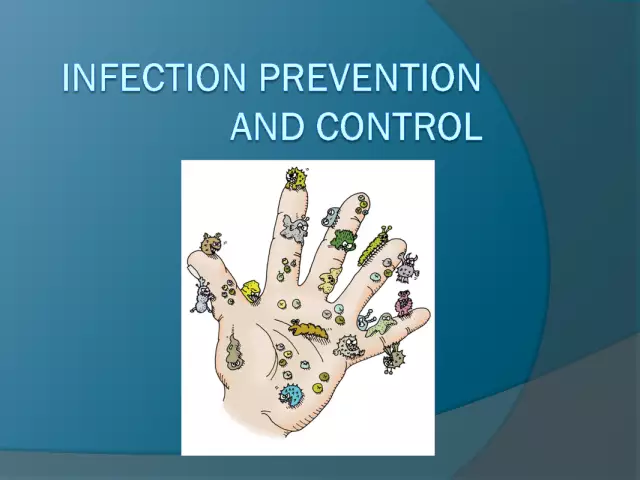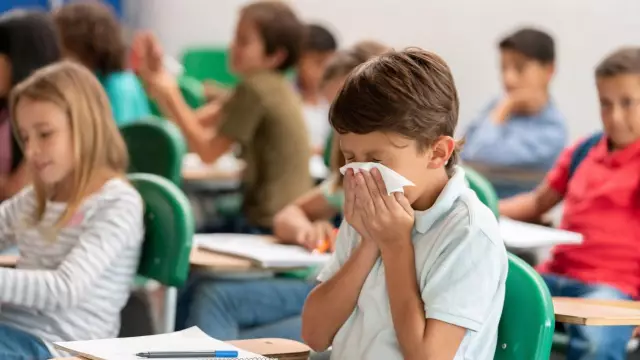- Author Rachel Wainwright [email protected].
- Public 2023-12-15 07:39.
- Last modified 2025-11-02 20:14.
Enterovirus infection
reference Information

Enterovirus infection refers to acute diseases of the gastrointestinal tract caused by enteroviruses. At the moment, more than 60 types of enteroviral pathogens are known. All of them are divided into 4 groups depending on the serotype. Most often, enterovirus infection is triggered by the activity of the Coxsackie viruses and poliomyelitis. The danger of enterovirus infection lies in the fact that its pathogens are extremely resistant to aggressive environmental factors. They can persist for a long time in moist soil and water, then entering the human body through the city water supply or contaminated food.
In early 2008, a large-scale enterovirus infection in children was recorded in China. It was caused by the EV71 virus, which has not manifested itself for the past several decades. It enters the body through the mucous membrane of the digestive tract or upper respiratory tract, and then spreads to the rest of the organs through the circulatory system, affecting, among other things, the lungs and the brain. Enterovirus infection was detected in more than 15,000 children, 20 of them died. This fact once again reminds us that when an enterovirus infection is diagnosed, treatment should be carried out immediately and be comprehensive.
Infection routes
The causative agents of enterovirus infection enter the external environment from the intestinal tract and nasopharynx, which determines the main routes of infection: airborne, water, food, contact and household. The role of individual factors in the transmission mechanism is not fully understood, therefore, the timing of the incubation period may vary depending on the state of the human immune system, the characteristics of a particular type of virus and environmental conditions. As a rule, enterovirus infection proceeds fairly easily and does not lead to any serious complications. Nevertheless, advanced forms of enterovirus infection affect a variety of organs and systems, provoke the development of serious diseases, in some cases end in death, which we, in fact, observed during the Chinese epidemic.
Symptoms of an enterovirus infection
After the end of the incubation period, patients develop the first alarming symptoms of enterovirus infection:
- fever;
- headache;
- pain in the abdominal region;
- nausea, sometimes vomiting.
These symptoms of enterovirus infection are mild, and in some cases the infection does not manifest itself at all. More serious signs are observed only after pathogens enter the circulatory system and spread through the vital systems of the body. From this point on, patients begin to complain about:
- increased body temperature;
- the appearance of a rash on the arms and legs;
- swelling of the limbs;
- mouth ulcers.
If the enterovirus infection continues to develop further, and the patient does not take any measures to get rid of it, it can lead to serious complications: meningitis, encephalitis, pulmonary edema and even paralysis. A neglected enterovirus infection in children and adults leads to death or significant brain damage and disability.
In recent years, the so-called small enterovirus infection has been increasingly detected in children. It is characterized by mild fever, weakness, muscle pain and usually goes away on its own after 2-3 days, without causing pronounced changes in individual organs.
Diagnosis of the disease
Enterovirus infection in adults is established only on the basis of laboratory test results. They take some time and for this period it is desirable to isolate the patient from other family members. Due to the rapid spread of infection, each case of infection is subject to registration. At the same time, unscheduled examinations of people who have been in contact with the patient are carried out. If during the research the diagnosis of enterovirus infection was confirmed, the symptoms and clinical course of the disease are reflected in a separate card of the epidemiological investigation.
Treatment of enterovirus infection

Currently, there are no specific methods for treating enterovirus infection. In the acute period, patients are prescribed bed rest, a diet rich in vitamins, and drinking plenty of fluids (vomiting and diarrhea can cause dehydration). If an enterovirus infection in children is accompanied by a high fever, as well as severe headaches and muscle pains, then the patient is recommended analgesics and antipyretics. In case of diarrhea, it is advisable to use drugs to restore the water-salt balance, for example, rehydron. Antibiotics are used only in cases of secondary bacterial infections.
The developed diet must meet the following conditions:
- foods that enhance intestinal motility are excluded from the diet (sweets, carbonated drinks, smoked meats, black bread, fresh vegetables and fruits, fatty and fried foods);
- food should be easily digestible;
- it is advisable to completely abandon the use of dairy products;
- if enterovirus infection in adults and children is accompanied by putrefactive processes, patients need to eat baked apples, which absorb toxic substances;
- It is best to give food frequently but in small portions. This applies to both adults and children.
Prevention of enterovirus infection is aimed at sanitary improvement of fresh water sources, adherence to the rules of personal hygiene, decontamination of sewage, providing the population with fresh, high-quality food and clean drinking water.
YouTube video related to the article:
The information is generalized and provided for informational purposes only. At the first sign of illness, see your doctor. Self-medication is hazardous to health!






